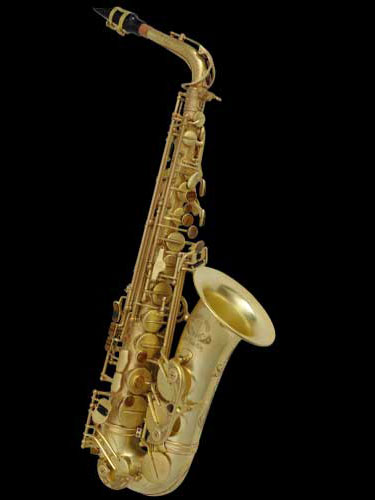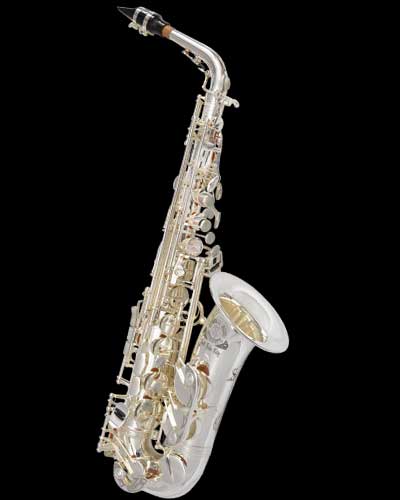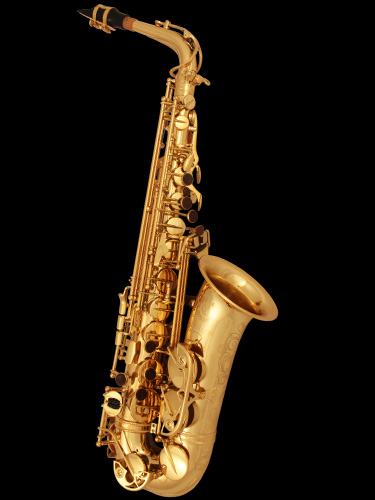
Selecting a Saxophone for Classical and Jazz Performance
Curated from BandWorld – by Dr. Tracy Heavner –
Introduction
There are many brands of saxophones currently being produced varying greatly in quality and price. Within their brand, most saxophone manufacturers also produce several different models in order to meet the needs of performers at various stages of development. Student models, designed for beginning saxophonists, are the least expensive but also contain the least amount of craftsmanship. Intermediate models, designed for advancing performers, are more expensive because they are made using better materials, more craftsmanship and contain a few extra features. Professional models, used mainly by advanced saxophonists, are the most expensive and are made using the best materials. They also contain the most craftsmanship and are equipped with extra features not included on other less expensive models.
A majority of saxophonists learn to play using a student model but as they improve, they upgrade to an intermediate instrument. Some saxophonists improve to a point that they consider purchasing a professional quality instrument dependent upon their budget and performance goals.
When selecting a saxophone to purchase, some factors to consider are the instrument’s tone quality, intonation, response, durability and price. Recommendations from saxophone teachers as well as professional performers are also important factors to consider when determining which saxophone would be the best choice for classical and jazz performance.
Popular Saxophone Brands and Models
Although there are many saxophone brands used by professional saxophonists, the two most popular are Selmer and Yamaha. Selmer saxophones have a long tradition as being the favorite of many professional performers, especially the Selmer Mark VI model, which was manufactured from 1954 through 1973. Currently Selmer’s two highest quality instruments are the Selmer Paris Series III, preferred by classical saxophonists and the Selmer Paris Reference 54, which was designed after the Selmer Mark VI and preferred by jazz performers. These instruments are used by many saxophonists and are excellent professional instruments.
In recent years, the Yamaha brand has become very popular with upcoming performers and even some seasoned Selmer artists. Yamaha also produces two professional quality instruments, one designed primarily for classical performers and the other for jazz. The Yamaha Custom 875 EX saxophone is a professional model saxophone that produces a rich, dark tone that is excellent for performing classical music. For performing in the jazz style, Yamaha produces the Yamaha Z model, which has a brighter tone and is endorsed by many jazz saxophonists. In addition to Selmer and Yamaha, several other saxophones brands that have reached a level of popularity, especially among jazz saxophonists, are Yanagisawa, Keilwerth and Cannonball.
While it is possible for some saxophonists to own two saxophones, one dedicated to classical performance and the other for jazz, due to a variety reasons, most saxophonists perform on only one saxophone. However, by modifying tone quality through embouchure adjustment and careful selection of mouthpieces, ligatures and reeds, saxophonists can usually make the necessary changes needed to perform in a variety of diverse musical styles using the same instrument.
Saxophone Finishes
In addition to the brand and model, another factor to consider when selecting a saxophone is the finish. The finish is a coating used to cover the bare brass of the saxophone, protecting it from the elements and also providing a more appealing appearance.
The type of finish will also have an effect on the tone. In addition to protecting the instrument and giving it a beautiful look, the finish also restricts the natural resonance of the brass and as a result, darkens the tone. Saxophones with the brightest tone are usually ones coated with no finish, which allows the brass to resonate freely. As a result, these instruments are very popular with jazz and commercial saxophonists even though their appearance may not be as appealing as other finished saxophones.
<Insert Figure 1.1: Cannonball Alto Saxophone No Finish>

When ranking the effect of finishes on tone quality, performers will discover that saxophones with a lacquer finish usually have the brightest tone, followed by black lacquer (it is thicker than other lacquered finishes), silver plated and finally gold plated. Saxophones finished in gold plating, which is the thickest saxophone finish and also the most expensive, will usually have the darkest tone with all other factors remaining equal.


When selecting a saxophone finish, both the appearance and tonal effect should be considered. However, saxophonists who choose a finish based more on appearance rather than tone quality can still influence the brightness or darkness of their tone. By adjusting the embouchure and selecting the appropriate mouthpiece, ligature and reed, saxophonists can brighten or darken their tone, fine-tuning it for each performance situation.
Choosing a Specific Saxophone
When selecting a saxophone, performers should research various brands, models and finishes using the Internet, learn about equipment used by top professional saxophonists, get recommendations from saxophone teachers and finally test play a variety of saxophones at larger music stores who have them in stock.
When the saxophone brand, model and finish have been decided, it is time to choose the specific instrument to purchase. Theoretically, saxophones of the same brand, model and finish should play identically to each other but unfortunately this not the case. Depending upon the brand and model, there can be quite a difference between individual instruments. The only way to find the best instrument is to test play several identical saxophones using the same mouthpiece, ligature and reed. Hopefully, a local music store will have several saxophones to choose from and practice rooms available to test play them.
If a local store does not have the desired saxophones in stock, some online instrument companies may ship several instruments at once for individuals to try for a short period of time.
Although this is not the most convenient way to select an instrument, serious saxophonists should always have several instruments to choose from.
When several identical instruments have been acquired, each should be test played for tone, intonation and response. When playing each instrument, saxophonists should listen carefully to see which instrument has the best tone and also check the intonation throughout the entire range of the instrument using a tuner. Although no saxophone is built perfectly in tune, only minor embouchure adjustments should be necessary to correct notes that are out of tune. Saxophonists should also check the instrument for response in the low, middle, high and altissimo registers.
If possible, each instrument should be recorded while being test played. It is often easier to determine which instrument sounds best using a recording since this allows performers to focus their full attention on each example rather than trying to play and listen at the same time. Many times if three saxophones are tested, one will stand out as being the worst and can be easily eliminated. However the other two instruments may be very close in playing characteristics. In this situation, it may take several more test plays to determine which instrument is best. In some cases, it may be obvious that one instrument plays far better than the other two making the choice of which instrument to purchase a simple one.
If a satisfactory instrument is found at a local store but the price is higher than buying the same instrument online, the store manager should be asked if the online price can be matched. Many times the local store will sell the instrument for the discounted online price.
Summary
When selecting a saxophone for classical and jazz performance, tone quality, intonation, response, durability and price along with recommendations from saxophone teachers as well as professional performers are factors that should be carefully considered. After the saxophone brand, model and finish have been determined through consideration of these factors, the specific saxophone can be discovered by carefully play testing several identical instruments. Through diligence, patience and by following these suggestions, both classical and jazz saxophonists should be able to select the best saxophone for their particular performance needs.
